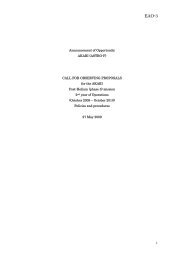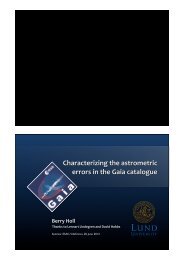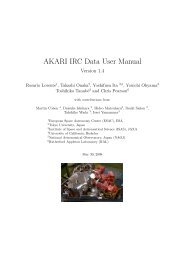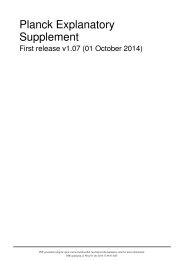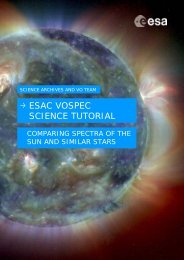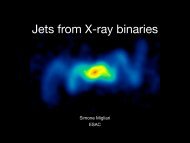You also want an ePaper? Increase the reach of your titles
YUMPU automatically turns print PDFs into web optimized ePapers that Google loves.
87. Calculate the latitude and longitude for the sunspots in each image, using thefollowing trigonometric formula:Latitude =−⎛⎜⎝( y − CENTER _ Y )R _ Sun⎞⎟⎠sin 1 ( ) ⎟− ⎛Longitude = sin 1 ⎜⎝x − CENTER _ XR _ Sun⎞⎠88. Record your values with the other values:27/12/2009 06:24 Sunspot (x, y) =Centre (CENTER_X, CENTER_Y) =Radius (R_SUN) =Latitude =Longitude =02/01/2010 18:42 Sunspot (x, y) =Centre (CENTER_X, CENTER_Y) =Radius (R_SUN) =Latitude =Longitude =89. Now calculate the difference in the longitude, remember that 0 degrees is in thecentre of the image, negative to the left and positive to the right. How manydegrees in longitude did the sunspot travel between the first and last images?ANSWER ~73.5 degrees.90. Calculate the difference in time between the first image and the last image (indays).ANSWER ~6.51 days.91. Calculate the Rotation in degrees per day, where Rotation = Difference inlongitude/Difference in days.ANSWER ~11.3 degrees/day.92. And finally, calculate how long it seems to take the Sun to make a full rotation of360 degrees: Solar Rotation = 360 degrees/ Rotation.ANSWER ~31.9 days for one rotation.93. SYNODIC ROTATION: Remember, the Earth is moving around the Sun in thesame direction at about 1 degree per day (almost 365 days to circle the Sun in ayear). Therefore, the rotation we have calculated will be larger than the actual solarrotation (we can assume that the <strong>SOHO</strong> satellite is at approximately the samedistance from the Sun as the Earth). This is called synodic rotation.21




